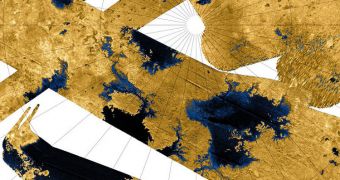Portions of Saturn's largest moon, Titan, may not experience rains for periods of time spanning up to 1,000 years, the results of a new study indicate. Other areas may receive more constant precipitations.
This discovery is very interesting because the moon is crisscrossed by rivers and lakes, all of which are filled with liquid hydrocarbons, such as methane and ethane. These chemicals undergo the same cycles as water does here on Earth.
However, unlike our planet, Titan does not have the necessary temperatures to allow liquid water to flow about. In fact, due to the extreme cold on the Saturnine moon, water is frozen so stiffly that it becomes tougher than granite is here on Earth.
The question then becomes, where do all these lakes and rivers get their hydrocarbons from? One logical explanation would be that the rivers fueling Titan's lakes get most of their liquids from areas where rains fall more consistently, not once per millennium.
However, investigators admit that there is no way to know for certain what actually goes on there, until we visit the moon. The proposed Titan Mare Explorer (TiME) mission could shed some light on this mystery, mission scientist, Dr. Ralph Lorenz, explains.
The expert holds an appointment with the Applied Physics Laboratory (APL), at the Johns Hopkins University (JHU). At the recent Lunar and Planetary Science Conference (LPSC), he argued for the selection of TiME as a future NASA mission to Titan.
The spacecraft carrying TiME would travel to the Saturnine system, enter Titan's extremely-thick atmosphere, and then land on Ligeia Mara, a massive methane lake. During descent, the probe would search for signs of storms in the air, although it's highly unlikely it will come across such an event.
After landing, it would work by listening for the methane rain, and also by analyzing the skies in search for methane rain. Plans call for the lander to be able to survey an area covering 1,200 square kilometers, Astrobiology Magazine reports.
“We might expect a 50% chance for a lander to be rained on directly in a 2500hr mission, but that its camera could observe nearby rainfall an expected ~5 times,” Dr. Lorenz explains. Without such a mission, it may be impossible to fully understand how Titan's hydrocarbon-based systems work.

 14 DAY TRIAL //
14 DAY TRIAL //